University of California, Riverside

The Future of Food
Across UCR, researchers are working to engineer and safeguard sustainable food sources for a shifting climate
Rooted in its history as a citrus experiment station and branching into a wide array of research areas, UC Riverside scientists and engineers are working to develop more sustainable crop varieties, address the agricultural challenges of climate change, and combat new and emerging pests. Read on to learn more about recent UCR research to safeguard our food supply for generations to come.
Hacking Marine Algae for a Sustainable Food Supply
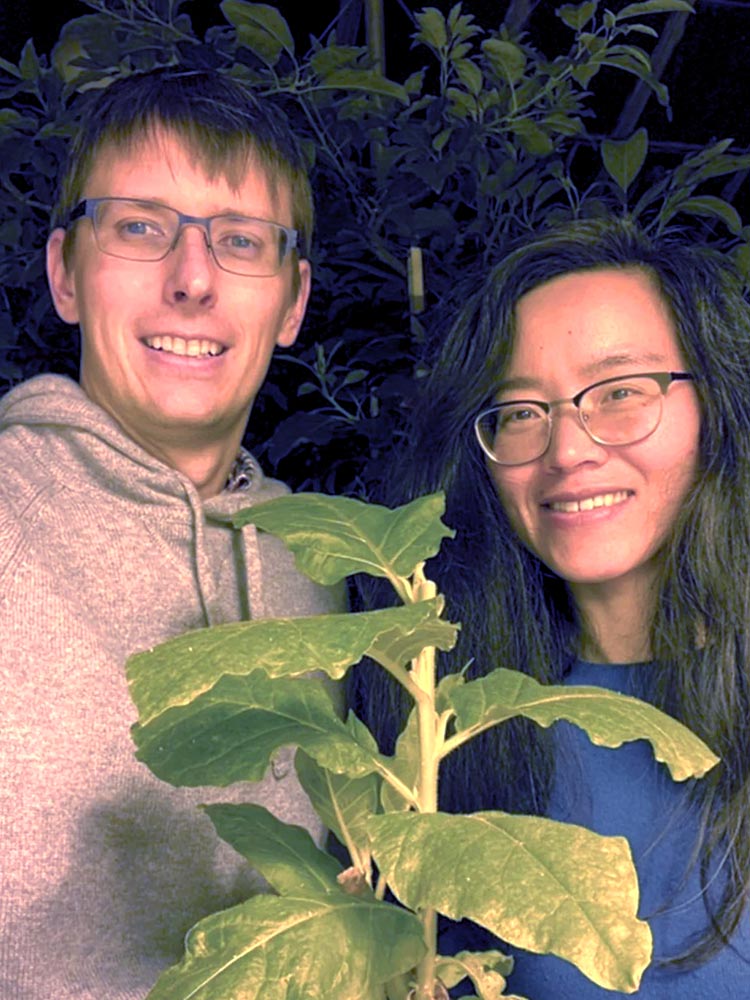
Jinkerson (left) and Xiang
Scientists have discovered the gene that enables marine algae to make a unique type of chlorophyll called chlorophyll c. By successfully implanting this gene in a land plant, they are paving the way for better crop yields on less land.
Chlorophyll is a pigment that enables photosynthesis, the process of converting light into chemical energy or “food.” Plants produce chlorophyll a and b, while most marine algae and kelp produce chlorophyll c, which enables them to absorb the blue-green light that reaches the water.
Finding the chlorophyll c gene solves a long-standing mystery about the molecular pathways that allow the algae to survive. The study also documents another first-of-its-kind achievement: demonstrating that a land plant can produce the marine chlorophyll. Tobacco plants were used in the experiment, but in theory, any land plant may be able to incorporate the marine algae gene, allowing them to absorb a wider spectrum of light and achieve better growth.
An additional application of the research could be in the production of algae biofuels. There are a few algae species that produce chlorophylls a or b, like land plants, instead of c. Imbuing those algae with the gene to make chlorophyll c could enhance their ability to use more light and increase their growth, creating more feedstock for the fuels.
“The identification of the biosynthetic pathway for chlorophyll c is more than a scientific curiosity; it’s a potential game changer for sustainable energy and food security,” said Robert Jinkerson, associate professor of chemical and environmental engineering, who co-led the study with Tingting Xiang, assistant professor of bioengineering.
Study results appear in the journal Current Biology.
Transforming Plants into Environmental Sensors
UCR researchers have successfully engineered a plant to turn beet red in the presence of a toxic pesticide. To achieve this, they had to solve an engineering puzzle: how to enable a plant to sense and react to a chemical in the environment without damaging its ability to function normally in all other respects.
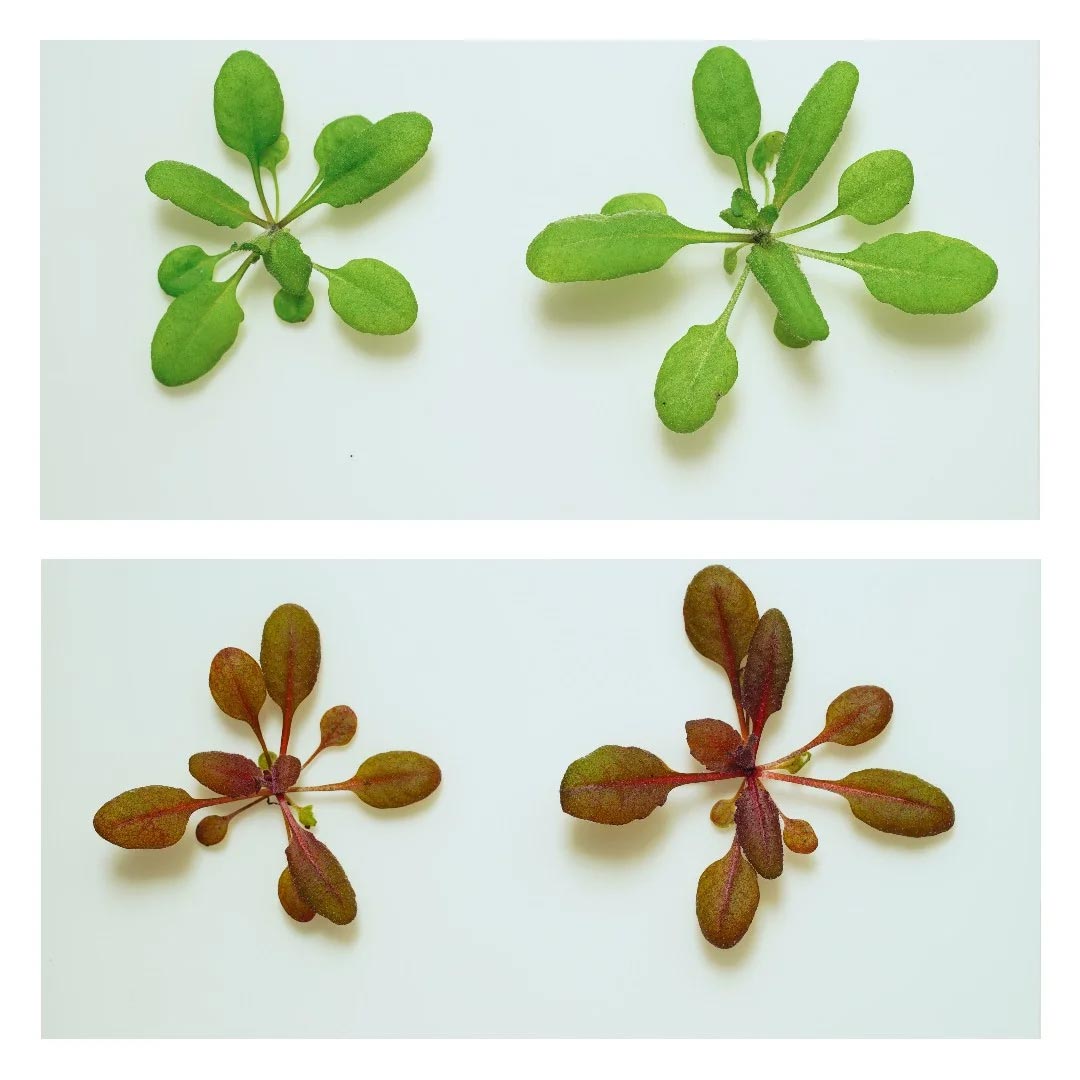
Laboratory plants, normally green, turn red in the presence of a toxic pesticide. (UCR/Sean Cutler)
The engineering process began with the team “hacking” a receptor protein that senses a plant hormone called abscisic acid, or ABA, which helps plants acclimate to stressful changes in the environment. The research team demonstrated that ABA receptor proteins can be trained to bind to chemicals other than ABA, a breakthrough that enabled them to create sensors for many chemicals, including banned pesticides. These new receptors can be used to create chemical diagnostic tests, but what the team wanted to do was engineer living plant sensors, which required extensive rewiring of the receptor system. Using their improved system, they successfully engineered plants to turn red when the receptor senses a target chemical. For this demonstration, the team used azinphos-ethyl, a pesticide banned in many places because it is toxic to humans.
“Our goal is to be able to easily detect chemicals in the environment from a distance,” said Sean Cutler, distinguished professor of plant cell biology, who co-led the study with Ian Wheeldon, professor of chemical and environmental engineering. “If you had a field of these and they turned red, that would be a pretty obvious visual indicator that someone was using the banned pesticide.”
Study results appear in the journal Nature Chemical Biology.
Defeating Crop-killing Gray Mold Without Toxins
If you’ve ever seen a fuzzy gray strawberry, you’ve seen gray mold. It causes billions in crop losses every year, infecting berries, tomatoes, and most other fruits and vegetables.
Now, UCR researchers have found a path toward defeating the mold without showering toxic chemicals on the crops. Being able to control it hinges on the discovery of lipid “bubbles” secreted by the mold cells, which some researchers previously dismissed as insignificant.
“Because they are hard to isolate and study, the important functions of these lipid bubbles, also called extracellular vesicles, have been overlooked for decades,” said Hailing Jin, professor of microbiology and plant pathology, who led the research project. “Now we know the mold, just like its plant hosts, also uses extracellular vesicles to protect and deliver what amount to weapons — small RNA molecules that silence genes involved in plants’ immune systems.”
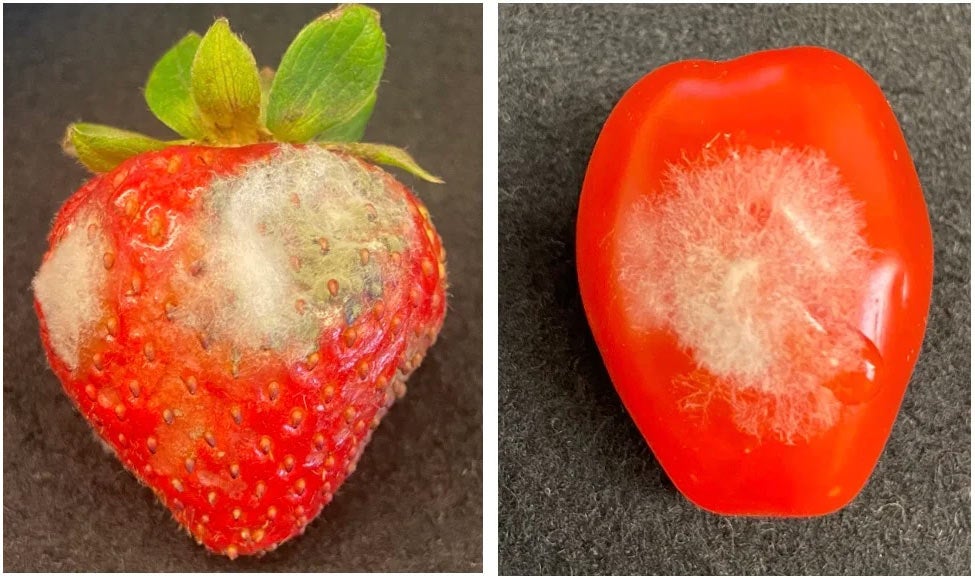
Gray mold growing on produce. (UCR/Hailing Jin)
The study not only showed that gray mold secretes virulent RNA in these lipid-based bubbles, but that a particular protein, tetraspanin, appears on the bubble’s surface and is key to the mold’s ability to produce them. The researchers found that if they eliminated the mold’s ability to make tetraspanin, it also largely reduced its ability to secrete and deliver the bubbles.
Previously, the same research team identified genes that allow the fungus to produce small RNA molecules. Knocking out those genes, as well as the ones that allow the fungus to make tetraspanin, would enable a new generation of environmentally friendly “RNA fungicides” that inhibit grey mold disease.
“With the climate changing so fast, many fungal infections can get worse,” Jin said. “We are excited to develop new eco-friendly methods of protecting the global food supply that may be so widely applicable.”
Study results appear in the journal Nature Communications.
Releasing a New Avocado to the World Marketplace
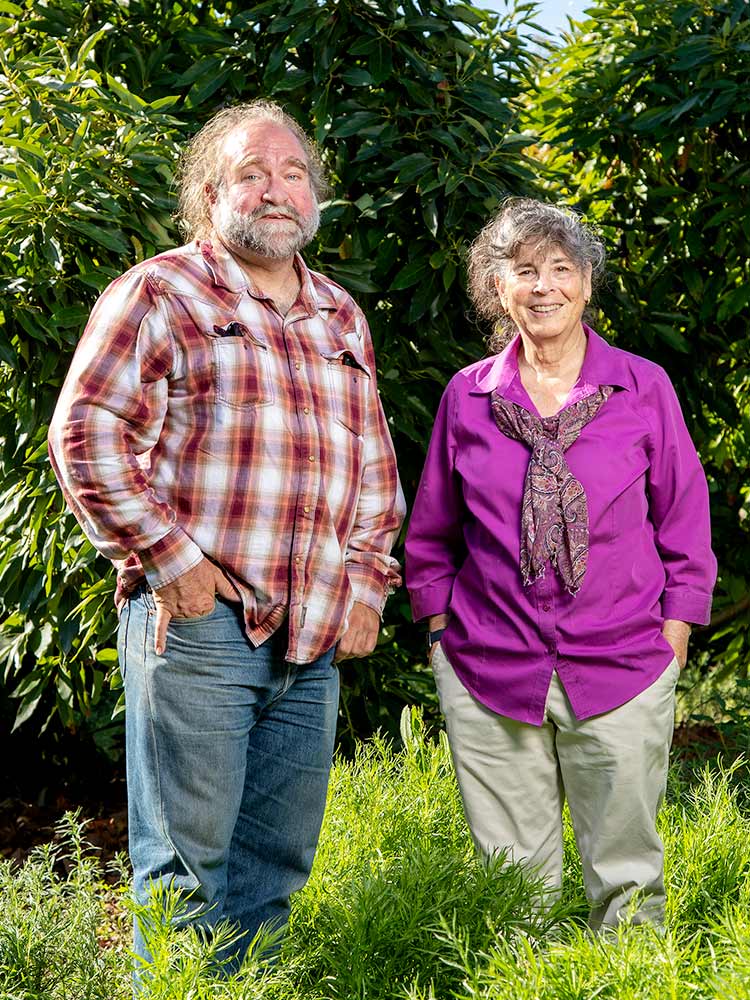
Focht (left) and Arpaia (UCR/Stan Lim)
A new avocado variety that’s more than a half-century in the making is now available to growers in the world marketplace.
The Luna UCR™ offers consumers great flavor, a rind that turns a tell-tale black when ripe, and high postharvest quality. Growers, meanwhile, will benefit from a smaller tree size, allowing denser plantings for more efficient and safer harvesting, and minimal pruning. It also has a type of flower that makes it an efficient pollinizer for various avocado varieties, including the stalwart Hass, the world’s leading variety. Planting the Luna UCR™ intermingled with other varieties could help ensure good yields by increasing pollination rates.
The patent for the Luna UCR™ credits UCR agricultural scientists Mary Lu Arpaia, a UC Cooperative Extension horticulturist, and her colleague Eric Focht, a staff research associate in the Botany and Plant Sciences Department. Co-inventors are former UCR scientists Gray Martin, the late David Stottlemyer, and the late B.O. “Bob” Bergh. The variety will be marketed to growers worldwide through a partnership with Eurosemillas, SA, a company based in Spain that specializes in international marketing of proprietary crop varieties.
The intergenerational development goes back to the work of Bergh in the 1950s, said Arpaia, who described him as UCR’s “first real, long-term avocado breeder.”
“Fruit breeding is a very long-term process,” Arpaia said. “So, you build upon the shoulders of your predecessors.”
Helping Rice Survive Drought and Flood
A UCR-led team has learned what happens to the roots of rice plants when they’re confronted with two types of stressful scenarios: too much water, or too little.
“This one crop is the major source of calories for upwards of 45% of humanity, but its harvests are in danger,” said Julia Bailey-Serres, distinguished professor and geneticist, who led the study. “In the U.S., floods rival droughts in terms of damage to farmers’ crops each year.”
While it is possible for rice plants to flourish in flooded soils, they yield less food or even die if the water is too deep for too long. The study simulated prolonged floods of five days or longer, in which plants were completely submerged. It also simulated drought conditions. One key finding involves a cork-like substance, suberin, that’s produced by rice roots in response to stress and helps protect the plants from both floods and drought.

Rice experiments conducted in a field by Bailey-Serres’ team. (UCR/Julia Bailey-Serres)
“Suberin is a lipid molecule that helps any water drawn up by the roots make it to the shoots and helps oxygen from shoots to reach roots,” Bailey-Serres said. “If we reinforce the plant’s ability to create suberin, rice has better chances for survival in all kinds of weather.”
The researchers were able to identify a network of genes that control suberin production and can use this information for gene editing or selective breeding. They also identified the genes controlling some of rice’s other stress behaviors.
“One of our interesting findings is that when rice plants are submerged in water, the root cell growth cycle goes on pause, then switches back on shortly after the shoots have access to air,” Bailey-Serres said. “Now that we understand these responses, we have a roadmap to make targeted changes to the rice genome that will result in a more stress-tolerant plant.”
Study results appear in the journal Developmental Cell.
Taking aim at a Grapevine Killer
Scientists at UC Riverside have a shot at eradicating a deadly threat to vineyards posed by the glassy-winged sharpshooter, just as its resistance to insecticide has been growing.
When the half-inch-long flying insect feeds on grapevines, it transmits bacteria that causes Pierce’s disease. Once infected, a vine is likely to die within three years — a growing problem for California’s $58 billion wine industry. Currently, it can only be controlled with quarantines and increasingly less effective chemical sprays, but new gene-editing technology represents hope for controlling the sharpshooter.
“Our team established, for the first time, genetic approaches to controlling glassy-winged sharpshooters,” said Peter Atkinson, professor of genetics and paper co-author.
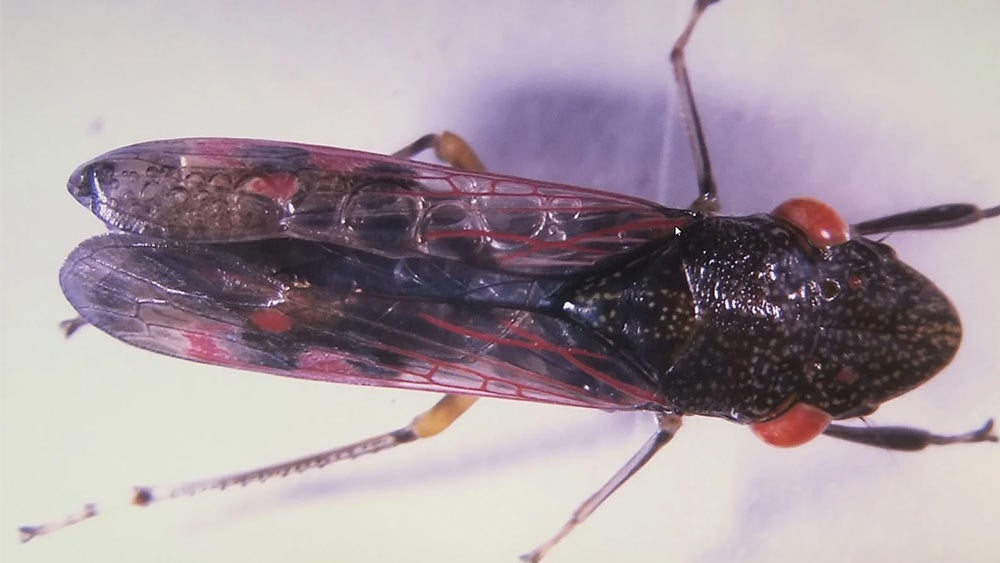
Modified sharpshooter with cinnabar colored eyes. (UCR/Inaiara de Souza Pacheco)
For this project, the researchers used CRISPR gene editing technology to knock out genes controlling the sharpshooters’ eye color. In one experiment, they turned the insects’ eyes white. In another, the eyes turned cinnabar, a blood-red color. Then, the team demonstrated these eye color changes were permanent, passed along to the offspring of the modified parents. Now that the team has demonstrated that CRISPR can work in these insects, they have a new goal.
“We’re using CRISPR to try and modify the mouth parts of the sharpshooter so they can’t pick up the bacteria that causes Pierce’s disease,” said Rick Redak, professor of entomology and paper co-author.
There is high likelihood the team will succeed in modifying the mouths, given the efficiency with which they were able to change the genes for the sharpshooters’ eye color.
“Before CRISPR, generating specific mutations with such ease at such high frequencies was virtually impossible,” Atkinson said. “Now we are confident we can come up with ways to create insects unable to transmit this disease.”
Study results appear in the journal Scientific Reports.
Boosting Crop Production with Black-eyed Peas

Sachs in a field of black eyed peas. (UCR/Joel Sachs)
Planting black-eyed peas in rotation with other crops could help growers avoid the need for costly, environmentally damaging fertilizers, according to UCR research.
The plant family that black-eyed peas belong to, legumes, are unique in their ability to obtain substantial amounts of nitrogen by attracting nitrogen-fixing bacteria called rhizobia. Tumor-like nodules in the plants’ roots protect the rhizobia and supply them with carbon. In return, the black-eyed peas receive a useful, fixed form of nitrogen.
“When the plant senses it is going to die, it releases the bacteria into the soil, replenishing it,” said UCR plant pathologist Gabriel Ortiz. “Growers could alternate seasons of legumes with other crops, leaving the soil full of nitrogen-fixing bacteria that reduce the need for fertilizer.”
As part of the study, the scientists tested whether black-eyed peas maintain their ability to attract rhizobia even after being subjected to modern farming practices. In many cases, plants heavily impacted by humans do not benefit as much from relationships with bacteria compared to their wild relatives. However, they found that the peas — a hugely popular food in many parts of the world — maintained their natural ability to form beneficial relationships with nitrogen-fixing bacteria.
“In fact, some of the strains in the experiment appear to have gained more benefit from bacteria than their wild ancestors,” said Joel Sachs, professor of evolution and ecology, who led the study. “To make agriculture more sustainable, one of the things we need to do is focus on the plant’s ability to get services from microbes already in the soil, rather than trying to get those services by dumping chemicals.”
Study results appear in the journal Evolution.